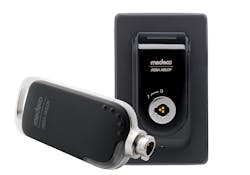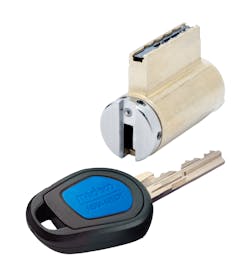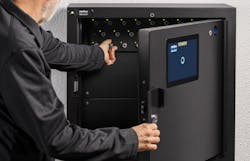5 Steps to Implementing an Intelligent-Key System
So your customer has decided to take their facility’s security to the next level. They’re looking to move beyond standard mechanical locks and keys to a system that will enable access control based on user profiles. They also seek enhanced “operational intelligence,” with access logs and audit trails that identify who accessed what locks and when.
Although they might not know it, what they’re requesting is an intelligent-key system. Such systems are aimed at schools, healthcare institutions and a host of other facilities that require a system that’s highly secure, affordable and easy to retrofit into existing door openings.
Intelligent-Key Benefits
Intelligent-key systems provide several benefits:
No electrical power necessary. Unlike other electronic access control (EAC) systems, intelligent-key systems that employ electromechanical cylinders and keys don’t require electrical power, hard-wiring, cables or changes to existing door hardware. As a result, upgrades can occur quickly and more cost-effectively than installing an EAC system.
Single key use. Intelligent keys are programmed to communicate with intelligent lock cylinders installed on doors as well as padlocks installed on gates, fences and cabinets. That means, in contrast with mechanical keys, keyholders have to carry only a single intelligent key to access thousands of locks.
Controlled access. Intelligent-key systems provide controlled access, accountability, physical security and system management all in a retrofit cylinder solution. To prevent unauthorized access to spaces, administrators can program keys to expire on a specific day and at a specific time — for example, at 5 p.m. on a Friday when a contractor completes a job. This action will disable the key until it’s revalidated. Most notably, intelligent keys can’t be duplicated.
Access logs and audit capability. Keys and cylinders used in intelligent-key systems record the date and time of day each time a lock is locked or unlocked, including all unauthorized attempts. Robust systems store up to 10,000 events in each key, and system administrators can view and export this data for analysis.
Easy changes. To address employee changes and turnover quickly and easily, system managers can grant or remove access via a computer or smartphone app. Even if a key isn’t returned when an employee leaves the company, the key itself can be rendered inoperable. The same holds true if a key were reported lost or stolen.
System growth. Of course, system administrators can update or add keys to the system whenever an opening is added or removed.
Implementing the System
Step One: Document Details.
Successful implementation of an intelligent-key system means knowing what hardware each door opening requires. This is why the site survey is critical. The locksmith, with the customer’s facility floor plans in hand, typically will spend time assessing and documenting the details of each opening, including the door hardware, its frame and threshold.
What type of cylinder is required? Is it a mortise or a rim cylinder, a key-in-lever cylinder or a key-in-knob cylinder? Does the lock have a small-format interchangeable core (SFIC) or large-format core? Does the opening require a padlock? If so, what’s the shackle size? All of these details are critical before the order for an intelligent-key system is placed.
Step Two: Install the Software
An intelligent-key system wouldn’t be smart without its software, which, of course, must be hosted on a computer server. In this area, your customer has two options.
- Install the software on servers located on premises. Often, for data security and privacy reasons, some government entities and healthcare facilities require that software be hosted on the entity’s own servers. In this case, tech support professionals often will guide end users through installation.
- Enlist a third party to host the software. For example, Amazon Web Services provides on-demand cloud computing platforms to individuals, companies and governments, on a metered, pay-as-you-go basis.
As with any enterprise software, regular updates and patches to address bugs are necessary to uphold the security and performance of the system. If the end user chooses to host the software locally (option 1), their IT personnel are responsible for installing regular updates and patches. If it’s hosted via a third party (option 2), the manufacturer manages all updates.
Whichever way your customer chooses to go, know that the software must be up and running before hardware installation can begin.
Step Three: Install Cylinders
As the locksmith, you’re responsible to manage the installation of products in your customer’s door openings and to program the intelligent keys, in accordance with your customer’s demands. In large facilities, such as a sizeable healthcare facility or government compound that has hundreds of door openings, installation can take as long as a few months to more than a year to complete.
Keep in mind that, when you manage retrofit upgrade projects, it’s important and cost-effective to choose a cylinder manufacturer that can retrofit other manufacturers’ cylinders. Not having to replace door hardware minimizes project costs and installation timelines.
Step Four: Program Keys and Locks
Next, the system administrator establishes user profiles in the system software. This feature enables robust scheduling for all authorized users. For example, full-time employees might be authorized to enter a facility Monday through Friday between the hours of 7 a.m. and 7 p.m., while cleaning staff can access buildings only between the hours of 6 p.m. and 2 a.m.
Step Five: Train System Administrators
When it comes to system education, there are a few options to train your customer’s administration team as to the ins and outs of the intelligent-key software. As the locksmith, you can conduct the training on-site, or you can rely on the manufacturer’s technical-services team to conduct the training — either in person or via teleconferencing.
Depending on the size of the installation and the number of individuals being trained, training might take several days. Typically, the customer’s preferred approach is decided at the onset of the project and outlined in detail in the project quote.
As a final step, administrators will distribute intelligent keys. Some users choose to program and hand out keys before installing cylinders, so no one is locked out of a space as new cylinders are installed. Others choose to coordinate cylinder installation with key distribution. This is simply a preference on the part of the end user.
Afterward
Intelligent cylinders require little physical maintenance outside of periodic cleaning and lubricating lock and key contacts. The frequency of lubrication depends on the location of the cylinder, weather conditions and frequency of use.
For example, a lock installed on an interior door that’s used a few times each day should be lubricated about once per year. However, locks installed on exterior entrance doors of an apartment building that has several hundred tenants and varying weather conditions should be lubricated at least four times per year or anytime it becomes difficult to insert or turn the intelligent key.
When planning an intelligent-key system project, it’s important to consider how keys will be stored. Effective key control is a critical aspect that often is overlooked. Many times, facility managers rely on a standard peg board that has hooks to manage keys for an entire facility, with no reliable way to prevent unauthorized individuals from accessing keys.
Administrators are encouraged to store keys in a secure cabinet. In fact, key cabinets are available that not only secure keys, but also distribute them effectively and maintain access records.
Andy Hummel is regional business development manager for Medeco Security Locks.
Medeco Systems
Medeco offers a choice of intelligent-key systems, depending on user preferences.
Each requires software installation and key programming and records the date and time a lock is accessed. In the event of a security issue, system administrators can export a report that details who accessed which locks and when, including unauthorized attempts.
The XT system employs keys that are digital and powered by a rechargeable battery that’s charged every 2–3 months. The key alerts the user when a charge is required. Through the XT Air App, administrators can update access by using their smartphone. XT locks can be used with small-format interchangeable core (SFIC) cylinders.
The CLIQ Intelligent Key system employs a traditional bladed key that’s powered by a replaceable coin cell battery. Locks are available in most standard finishes. Administrators can use the CLIQ Connect app to update access authorizations.
For more information, visit www.medeco.com
Andy Hummel
Andy Hummel is regional business development manager for Medeco Security Locks.









